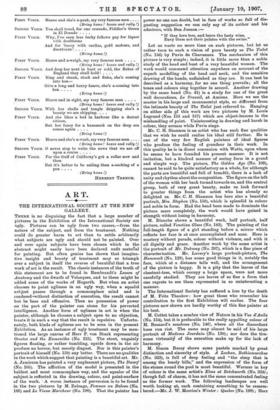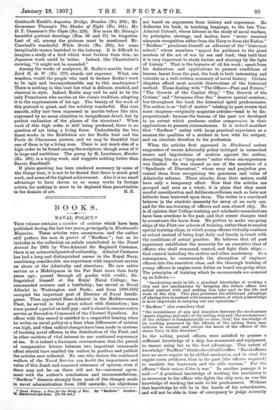ART.
THE INTERNATIONAL SOCIETY AT THE NEW GALLERY.
THERE is no disguising the fact that a large number of pictures in the Exhibition of the International Society are ugly. Pictures can be ugly from two causes,—from the nature of the subject, and from the treatment. Nothing could do greater harm to art than to settle arbitrarily what subjects are ugly and should hot be painted. Over and over again subjects have been chosen which in the abstract might easily have been declared unfit matenal for painting. But often genius has shown that imagina- tive insight and beauty of treatment may so triumph over a subject in itself the reverse of beautiful that a true work of art is the result. The classic instances of the truth of this statement are to be found in Rembrandt's Lesson of Anatomy and the dwarfs of Velasquez, and to these might be added some of the works of Hogartb. But when an artist chooses to paint ugliness in an ugly way, when a squalid subject passes through a commonplace mind and is rendered without distinction of execution, the result cannot but be base and offensive. Then no possession of power on the part of the painter can atone for his perverted intelligence. Another form of ugliness in art is when the painter, although he chooses a subject open to no objection, treats it in such a way that the result is repulsive. Unfortu- nately, both kinds of ugliness are to be seen in the present Exhibition. As an instance of ugly treatment may be men- tioned the large canvas of Herr F. von Stack representing Orestes and the Eumenides (No. 225). The stout, ungainly figures floating, or rather tumbling, upside down in the air produce no horror, but merely disgust. Nor is this painter's portrait of himself (No. 159) any better. There are no qualities in the work which suggest that painting is a beautiful art. Mr•. A. Jamieson has painted a very unpleasant picture, The Dwarf (No. 105). The affliction of the model is presented in the baldest and most commonplace way, and the squalor of the subject is reflected in the drawing, colour, and paint-sur•face of the work. A worse instance of perversion is to be found in the two pictures by M. Zuloags, Femmes an Balton (No. 168) and Le Vices Marcheur (No. 190). That the painter has
power no one can doubt, but in face of works so full of dis- gusting suggestion we can only say of its author and his admirers, with Ben Jonson :—
"If they love lees, and leave the lusty wine, Envy them not their palates with the swine."
Let us waste no more time on such pictures, but let us rather turn to such a vision of pure beauty as The Toilet (No. 156) by Pavia de Cheyennes. The mechanism of this picture is very simple ; indeed, it is little more than a noble study of the head and bust of a very beautiful woman. The work would command attention anywhere on account of the superb modelling of the head and neck, and the sensitive drawing of the hands, unfinished as they are. It can beat be described as a harmony, for no one thing prevails ; all the tones and colours sing together in accord. Another drawing by the same hand (No. 41) is a study for one of the great wall decorations, Le Travail, at Amiens. Here we see the master in his large and monumental style, so different from the intimate beauty of The Toilet just referred to. Hanging on either aide V this work are two pictures by M. Louis Legrand (Nos. 155 and 157) which are object-lessons in the mishandling of paint. Uninteresting in drawing and harsh in colour, they scream while Pavia sings.
Mr. C. H. Shannon is an artist who has such fine qualities that we wish he could realise his ideal still further. He is one of the very few English painters of ideal figures who produce the feeling of grandeur in their work. In this quality he is in direct connexion with Watts, upon whom he seems to have founded his present manner. It is not imitation, but a kindred manner of seeing form in a grand and simple way. The picture, The Golden Age (No. 109), cannot be said to be quite satisfactory as a whole, for although the partiare beautiful and full of breadth, there is a lack of unity and rhythm about the composition. The figure on the left of the woman with her back turned towards us, and the central group, both of very great beauty, make ns look forward to greater things from the artist who has already so delighted us. Mr. C. H. Shannon has here also a beautiful portrait, Mrs. Stephen (No. 150), which is splendid in colour and noble in form. Had the head been made to dominate the picture more completely, the work would have gained in strength without losing in harmony.
M. Blanche shows a beautiful work, half portrait, half picture, called Venetian Glass (No. 183). The painting of the full-length figure of a girl standing before a mirror which reflects her face is at once accomplished and sane. Here is mastery without parade, colour without violence, and with it all dignity and grace. 'Another work by the same artist is the portrait of Mr. Dubussy (No. 207), which is a fine piece of characterisation. Mr. Lavery's large portrait-picture, The Hammock (No. 129), has some good things in it, notably the face, which at a distance tells well, and the arrangement of the picture is happy. It is a pity that the leaves of the chestnut-tree, which occupy a large space, were not more carefully studied. They are leaves of so fine a form that one regrets to see them represented in so uninteresting a manner.
The International Society has suffered a loss by the death of. M. Fritz Thaulow : how great those who remember his contribution to the first Exhibition will realise. The four pictures now shown are hardly worthy of this fine painter at his best.
M. Cottet takes a sombre view of Nature in his Vise d'Avila (No. 154), but it is preferable to the really appalling colour• of M. Besnard's seashore (No. 146), where all the discordant hues run riot. The same may almost be said of his large portrait of Madame Tourclain (No. 130); nor does the tire- some virtuasit; of the execution make up for the lack of harmony.
M. Simon Busay shows some pastels marked by great distinction and sincerity of style. A Locluzn, Bothiemurchus (No. 323), is full of deep feeling and "the sleep that is among the lonely hills," and the expression of the form of the stones round the pool is moat beautiful. Warmer• in key of colour is the same artist's Elms at Betchworth (No. 324); though full of charm, it has not the same concentrated feeling as the former work. The following landscapes are well worth looking at, each containing something to be remem- bered:—Mr. J. W. Morrice's Winter : Quebec (No. 199) ; Herr
Gotthardt Keuhrs Augustus Bridge, Dresden (No. 200); Mr. Grosvenor Thomas's The Shades of Night (No. 201); Mr. D. Y. Cameron's The Clyde (No. 218). Nor must Mr. Strang's beautiful portrait drawings (Nos. 56 and 57) be forgotten. Last of all, among the pictures must be mentioned Mr. Crawhall's wonderful White Drake (No. 306), for some inexplicable reason banished to the balcony. It is difficult to imagine a study of a bird which went further than this; no Japanese work could be better. Indeed, like Chanticleer's crowing, "it might not be amended."
Among the works of sculpture, M. Rodin's, marble bust of Lord H. de W. (Nd. 279) stands out supreme. What, one wonders, would the people who used to declare RAM's work to be ugly and incomprehensible say to this masterpiece ? There is nothing in this bust but what is delicate, studied, and classical in style. Indeed, Rodin may well be said to be the Only Frenchman who carries on the classic tradition, adapting it to the requirements of his age. The beauty of the work of this portrait is great, and the subtlety wonderful. Has ever smooth, silky hair been expressed in marble before, like this, expressed by no mean attention to insignificant detail, but by perfect realisation of the planes of the structure ? When work of this high order is still being produced, there is no question of art being a living force. Undoubtedly the two finest works in the Exhibition are the Rodin bust and the Puvis de Chavannes picture, and we may be thankful that one of them is by a living man. There is not much else of a high order to be found among the sculpture, though some of it is large and ambitious. The group by M. Lambeaux, Murder (No. 281), is a trying work, and suggests nothing better than Baccio Bandinelli.
If plain speaking has been rendered necessary by some of the things here, it is not to be denied that there is much good work, and some of the highest achievement. Also it is no small advantage to have shown us so many works by foreign artists, for nothing is more to be deplored than parochialism







































 Previous page
Previous page